Effect of Evaporator Position on Heat Pump Assisted Solid Desiccant Cooling Systems
Abstract
:1. Introduction
- The HPDC system model with different evaporator positions and corresponding control strategies was developed by EnergyPlus. The desiccant wheel model was validated by the performance data.
- The indoor thermal comfort and the change of indoor temperature/humidity with the different configuration of HPDC system under various climatic conditions were studied.
- This paper analysed the performance trend of the HPDC system and the respective characteristics of each configuration and defined the stable operation conditions of HPDC system.
2. Simulation Description and Methodology
2.1. System Structure and Simulation Conditions
2.1.1. Air Handling Process and System Sizing Method
2.1.2. Indoor and Outdoor Conditions Used in the Simulations
2.2. System Components Modelling and Performance Evaluation Methods
2.2.1. Desiccant Wheel Modelling
2.2.2. Heat Pump Modelling
2.2.3. System Performance Evaluation Parameters
3. Results and Discussion
3.1. Indoor Thermal Comfort and Energy Consumption Analysis of Existing Systems
3.1.1. Indoor Thermal Comfort Analysis
3.1.2. Energy Consumption and Performance of the HPDC Systems
3.2. Dehumidification Characteristics of the HPDC System
3.3. Characteristics of the HPDC Systems under Different Climate Conditions
4. Conclusions
- In high latitude areas, the HPDC system can control the indoor temperature and humidity within the thermal comfort zone throughout the cooling season. It should be noted that the dehumidification capacity of the system B is insufficient under the low regeneration temperature provided by condensation heat. The remaining 24.3% and 19% of the latent heat were therefore handled by the heat pump in July and August.
- The dehumidification capacity of the HPDC system has improved with the increase in outdoor humidity. On the contrary, the DCOP of the desiccant wheel will decrease due to the increase in the demand for regeneration heat.
- The increases with the rise in outdoor temperature and humidity. When outdoor temperature exceeds the return air temperature, an increase in outdoor humidity is more conducive to the improvement of system performance and the can respectively reach 4.1 and 3.9 at 0.02 kg/kg DA. On the contrary, the energy efficiency of the PTACR system drops to 1.8.
- The condensation heat is insufficient for system B when the outdoor temperature is lower than the indoor design temperature under two high humidity climates, which causes the indoor humidity discomfort in the 14% and 3.6% system operation time. However, system A can regenerate the desiccant completely from condensation heat and achieve comfort indoor environment.
- In the aforementioned high-humidity climate, the energy consumption of the reheat heater in the PTACR system has increased by five times and six times compared with operating in Seoul. Therefore, the HPDC system has a better energy-saving effect. Compared with the PTACR system, system A reduces the energy consumption by more than 60%. System B with the auxiliary regeneration heat source can also reduce energy consumption by more than 50%.
- This study discussed the effect of HPDC systems on indoor temperature and humidity control in different climates.
- Through the analysis of energy efficiency, it is found that the low temperature and high humidity climate is more conducive to improving the performance of the HPDC system.
- System A is more suitable for applications in high humidity areas when only the condenser heat is used for regeneration.
Author Contributions
Funding
Conflicts of Interest
Nomenclature
| Latin Symbols | |
| specific heat (J/kg K) | |
| DCOP | dehumidification coefficient of performance |
| ε | energy efficiency |
| E | electrical consumption (W) |
| mass fraction of desiccant in the wheel (kg/kg) | |
| h | convection heat transfer coefficient (W/m2 K) |
| mass transfer coefficient (kg/m2 s) | |
| latent heat of evaporation (J/kg) | |
| air mass flow (kg/s) | |
| MC | modifier curve |
| N | number of desiccant-air heat transfer units |
| PL | part load fraction |
| Q | cooling capacity of system (W) |
| T | dry-bulb temperature (°C) |
| u | air velocity (m/s) |
| the actual airflow fraction | |
| W | humidity ratio (kg/kg DA) |
| Y | water content in the desiccant material (kg/kg) |
| Greek symbols | |
| α | specific surface area of desiccant wheel |
| ρ | density(kg/m3) |
| ε | porosity of desiccant |
| λ | time constants of explicit analytic solution |
| τ | dimensionless time |
| κ | relative thermal capacity of desiccant wheel to air |
| θ | wet-bulb temperature (°C) |
| Subscript | |
| air | |
| condenser inlet | |
| desiccant layer | |
| evaporator inlet | |
| energy input ratio | |
| fan | |
| heat pump | |
| motor of desiccant wheel | |
| outdoor air | |
| process side of desiccant wheel | |
| process side inlet air | |
| process side outlet air | |
| regeneration side of desiccant wheel | |
| reheat heater | |
| regeneration side inlet air | |
| regeneration side outlet air | |
| entire system | |
| total cooling capacity | |
| vapour | |
| water | |
References
- O’Kelly, M.; Walter, M.E.; Rowland, J.R. Simulated hygrothermal performance of a desiccant-assisted hybrid air/water conditioning system in a mixed humid climate under dynamic load. Energy Build. 2015, 86, 45–57. [Google Scholar] [CrossRef]
- Li, Z.; Chen, W.; Deng, S.; Lin, Z. The characteristics of space cooling load and indoor humidity control for residences in the subtropics. Build. Environ. 2006, 41, 1137–1147. [Google Scholar] [CrossRef]
- Fong, K.F.; Lee, C.K.; Chow, T.T.; Fong, A.M.L. Investigation on solar hybrid desiccant cooling system for commercial premises with high latent cooling load in subtropical Hong Kong. Appl. Therm. Eng. 2011, 31, 3393–3401. [Google Scholar] [CrossRef]
- Dong, C.; Qi, R.; Zhang, L.; Lu, L. Performance enhancement of solar-assisted liquid desiccant dehumidifiers using super-hydrophilic surface. Energy Build. 2019, 199, 461–471. [Google Scholar] [CrossRef]
- Cho, H.J.; Jeong, J.W. Evaluation of thermal comfort in an office building served by a liquid desiccant-assisted evaporative cooling air-conditioning system. Energy Build. 2018, 172, 361–370. [Google Scholar] [CrossRef]
- Liu, S.; Jeong, J.W. Energy performance comparison between two liquid desiccant and evaporative cooling-assisted air conditioning systems. Energies 2020, 13, 522. [Google Scholar] [CrossRef] [Green Version]
- Jani, D.B.; Mishra, M.; Sahoo, P.K. Investigations on effect of operational conditions on performance of solid desiccant based hybrid cooling system in hot and humid climate. Therm. Sci. Eng. Prog. 2018, 7, 76–86. [Google Scholar] [CrossRef]
- Kashif Shahzad, M.; Ali, M.; Ahmed Sheikh, N.; Qadar Chaudhary, G.; Shahid Khalil, M.; Rashid, T.U. Experimental evaluation of a solid desiccant system integrated with cross flow Maisotsenko cycle evaporative cooler. Appl. Therm. Eng. 2018, 128, 1476–1487. [Google Scholar] [CrossRef]
- Narayanan, R.; Halawa, E.; Jain, S. Performance characteristics of solid-desiccant evaporative cooling systems. Energies 2018, 11, 2574. [Google Scholar] [CrossRef] [Green Version]
- Narayanan, R.; Halawa, E.; Jain, S. Dehumidification potential of a solid desiccant based evaporative cooling system with an enthalpy exchanger operating in subtropical and tropical climates. Energies 2019, 12, 2704. [Google Scholar] [CrossRef] [Green Version]
- Ge, T.S.; Dai, Y.J.; Wang, R.Z. Analysis on integrated low grade condensation heat powered desiccant coated vapor compression system. Appl. Therm. Eng. 2018, 138, 307–318. [Google Scholar] [CrossRef]
- Hua, L.J.; Ge, T.S.; Wang, R.Z. Extremely high efficient heat pump with desiccant coated evaporator and condenser. Energy 2019, 170, 569–579. [Google Scholar] [CrossRef]
- Vivekh, P.; Bui, D.T.; Kumja, M.; Islam, M.R.; Chua, K.J. Theoretical performance analysis of silica gel and composite polymer desiccant coated heat exchangers based on a CFD approach. Energy Convers. Manag. 2019, 187, 423–446. [Google Scholar] [CrossRef]
- Erkek, T.U.; Gungor, A.; Fugmann, H.; Morgenstern, A.; Bongs, C. Performance evaluation of a desiccant coated heat exchanger with two different desiccant materials. Appl. Therm. Eng. 2018, 143, 701–710. [Google Scholar] [CrossRef]
- Yao, Y.; Dai, L.; Jiang, F. Photo-crosslinked nanofibrous membranes as advanced low-temperature regenerative desiccant. Polym. Test. 2019, 78. [Google Scholar] [CrossRef]
- Asadi, A.; Roshanzadeh, B. Improving performance of two-stage desiccant cooling system by analyzing different regeneration configurations. J. Build. Eng. 2019, 25, 100807. [Google Scholar] [CrossRef]
- Chaudhary, G.Q.; Ali, M.; Sheikh, N.A.; Gilani, S.I.U.H.; Khushnood, S. Integration of solar assisted solid desiccant cooling system with efficient evaporative cooling technique for separate load handling. Appl. Therm. Eng. 2018, 140, 696–706. [Google Scholar] [CrossRef]
- Angrisani, G.; Roselli, C.; Sasso, M.; Tariello, F.; Vanoli, G.P. Performance assessment of a solar-assisted desiccant-based air handling unit considering different scenarios. Energies 2016, 9, 724. [Google Scholar] [CrossRef] [Green Version]
- Luo, W.J.; Faridah, D.; Fasya, F.R.; Chen, Y.S.; Mulki, F.H.; Adilah, U.N. Performance enhancement of hybrid solid desiccant cooling systems by integrating solar water collectors in Taiwan. Energies 2019, 12, 3470. [Google Scholar] [CrossRef] [Green Version]
- Li, H.; Dai, Y.J.; Köhler, M.; Wang, R.Z. Simulation and parameter analysis of a two-stage desiccant cooing/heating system driven by solar air collectors. Energy Convers. Manag. 2013, 67, 309–317. [Google Scholar] [CrossRef]
- Hwang, W.B.; Choi, S.; Lee, D.Y. In-depth analysis of the performance of hybrid desiccant cooling system incorporated with an electric heat pump. Energy 2017, 118, 324–332. [Google Scholar] [CrossRef]
- Ge, F.; Wang, C. Exergy analysis of dehumidification systems: A comparison between the condensing dehumidification and the desiccant wheel dehumidification. Energy Convers. Manag. 2020, 224, 113343. [Google Scholar] [CrossRef]
- Martínez, P.J.; Llorca, C.; Pla, J.A.; Marténez, P. Experimental validation of the simulation model of a DOAS equipped with a desiccant wheel and a vapor compression refrigeration system. Energies 2017, 10, 1330. [Google Scholar] [CrossRef] [Green Version]
- Chen, C.H.; Hsu, C.Y.; Chen, C.C.; Chiang, Y.C.; Chen, S.L. Silica gel/polymer composite desiccant wheel combined with heat pump for air-conditioning systems. Energy 2016, 94, 87–99. [Google Scholar] [CrossRef]
- Kang, H.; Lee, G.; Lee, D.Y. Explicit analytic solution for heat and mass transfer in a desiccant wheel using a simplified model. Energy 2015, 93, 2559–2567. [Google Scholar] [CrossRef]
- Kang, H.; Choi, S.; Lee, D.Y. Analytic solution to predict the outlet air states of a desiccant wheel with an arbitrary split ratio. Energy 2018, 153, 301–310. [Google Scholar] [CrossRef]
- Ruivo, C.R.; Carrillo-Andrés, A.; Costa, J.J.; Domínguez-Muñoz, F. A new approach to the effectiveness method for the simulation of desiccant wheels with variable inlet states and airflows rates. Appl. Therm. Eng. 2013, 58, 670–678. [Google Scholar] [CrossRef]
- Ruivo, C.R.; Costa, J.J.; Figueiredo, A.R.; Kodama, A. Effectiveness parameters for the prediction of the global performance of desiccant wheels—An assessment based on experimental data. Renew. Energy 2012, 38, 181–187. [Google Scholar] [CrossRef]
- Niemann, P.; Richter, F.; Speerforck, A.; Schmitz, G. Desiccant-assisted air conditioning system relying on solar and geothermal energy during summer and winter. Energies 2019, 12, 3175. [Google Scholar] [CrossRef] [Green Version]

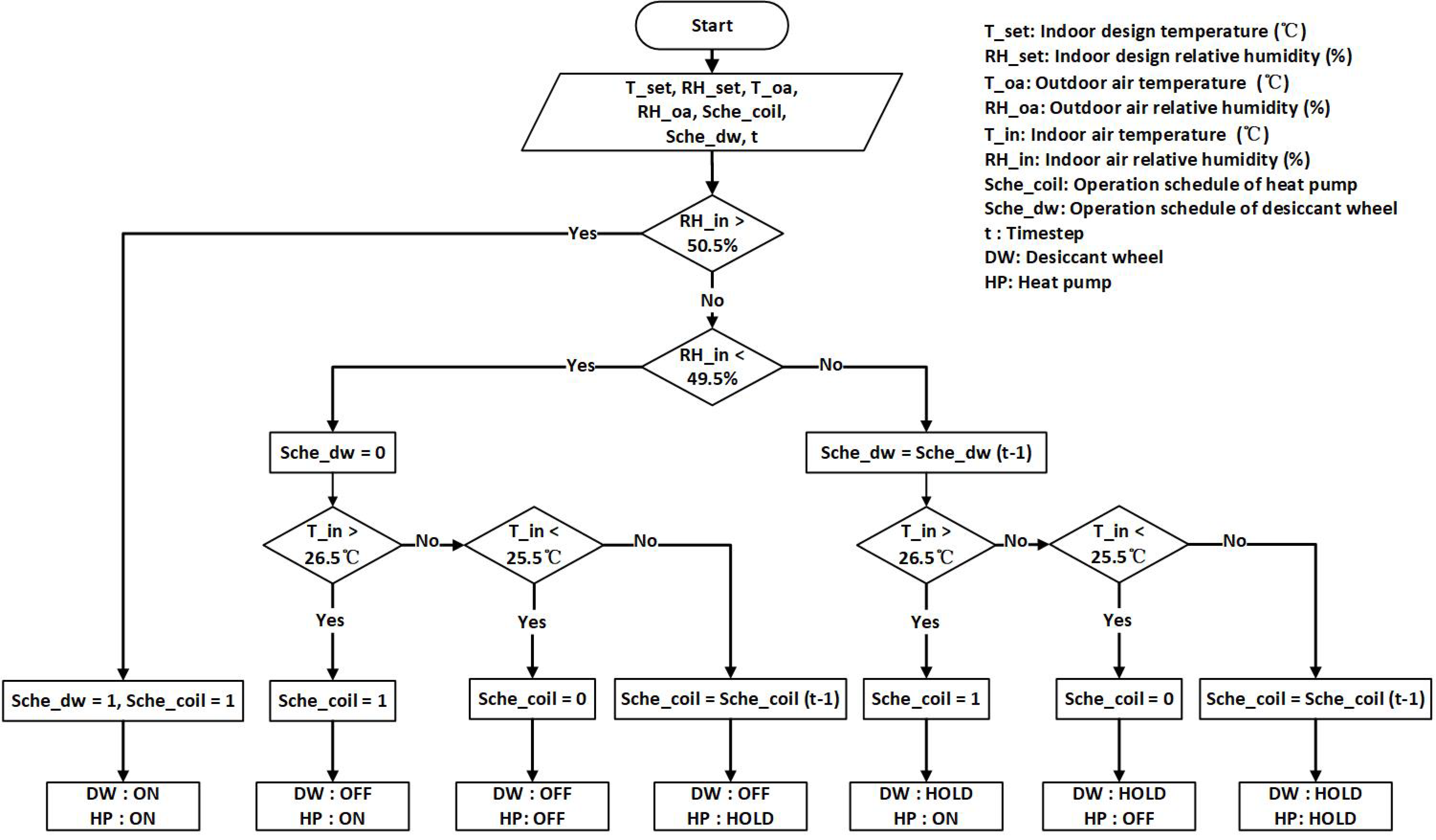


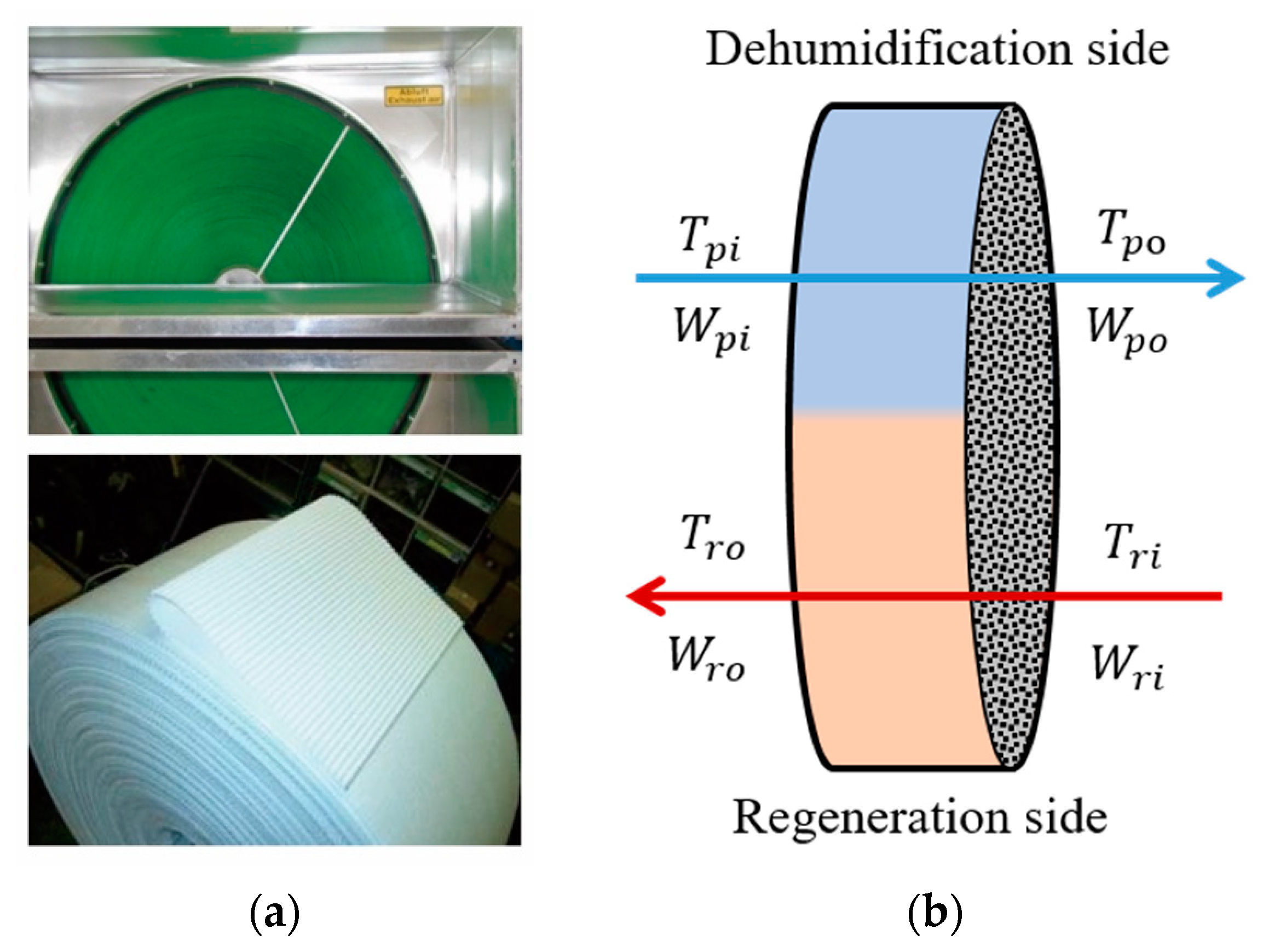
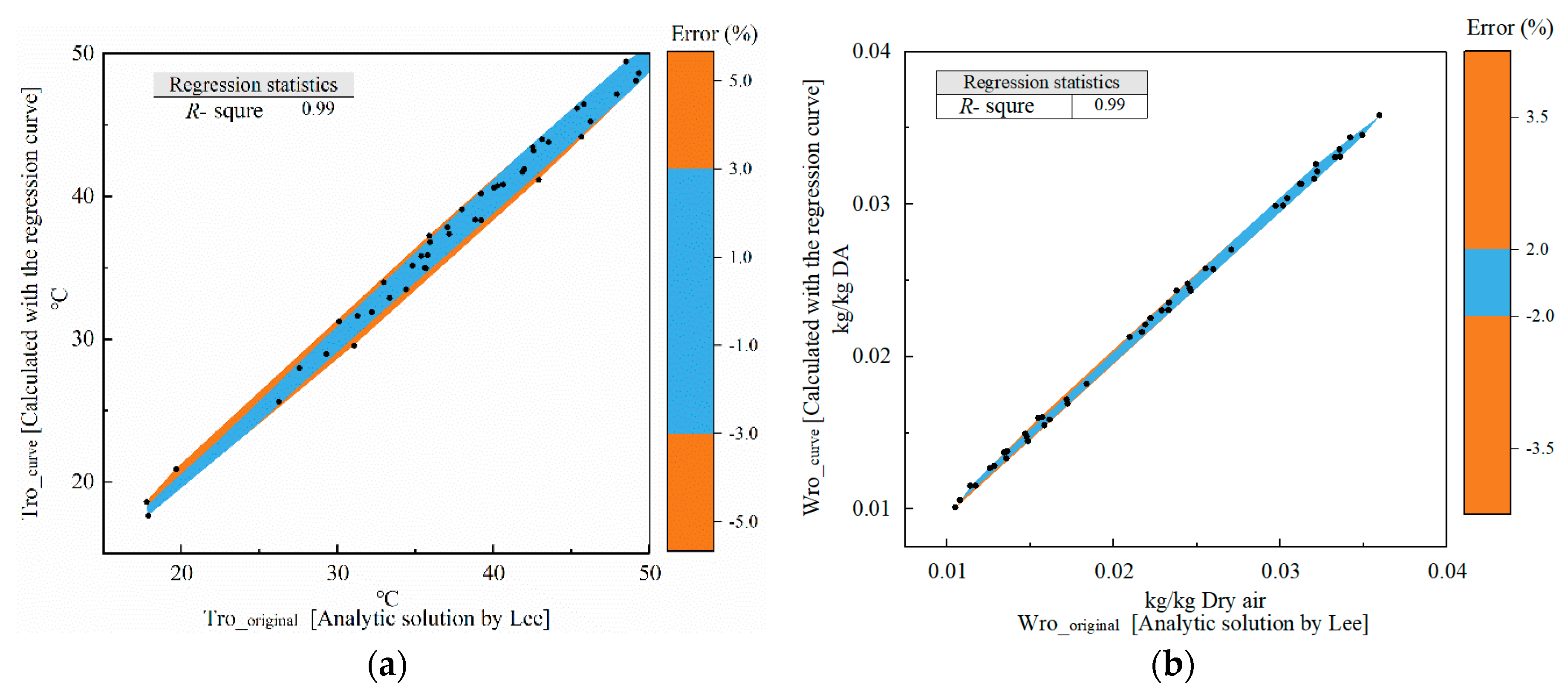
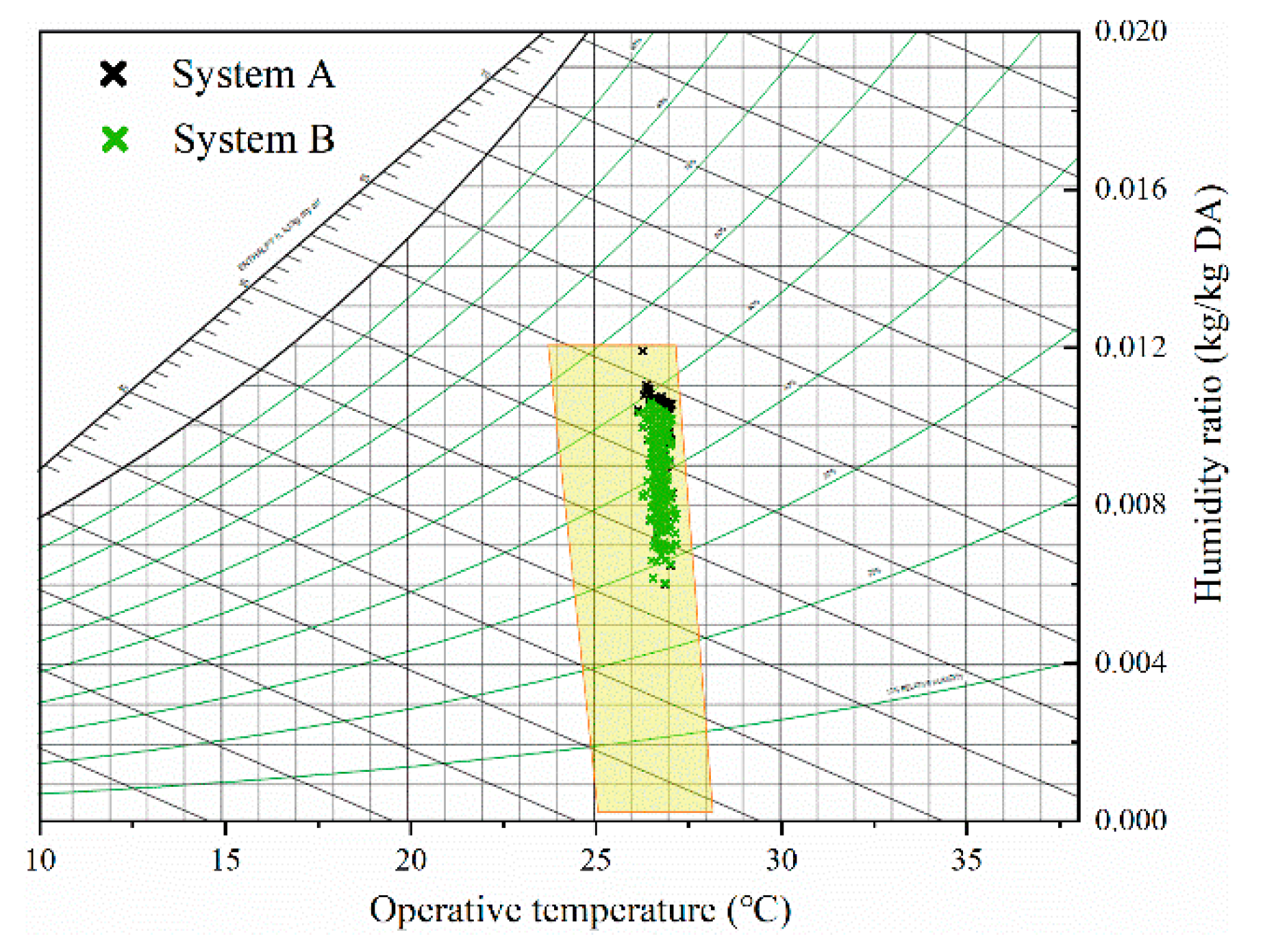
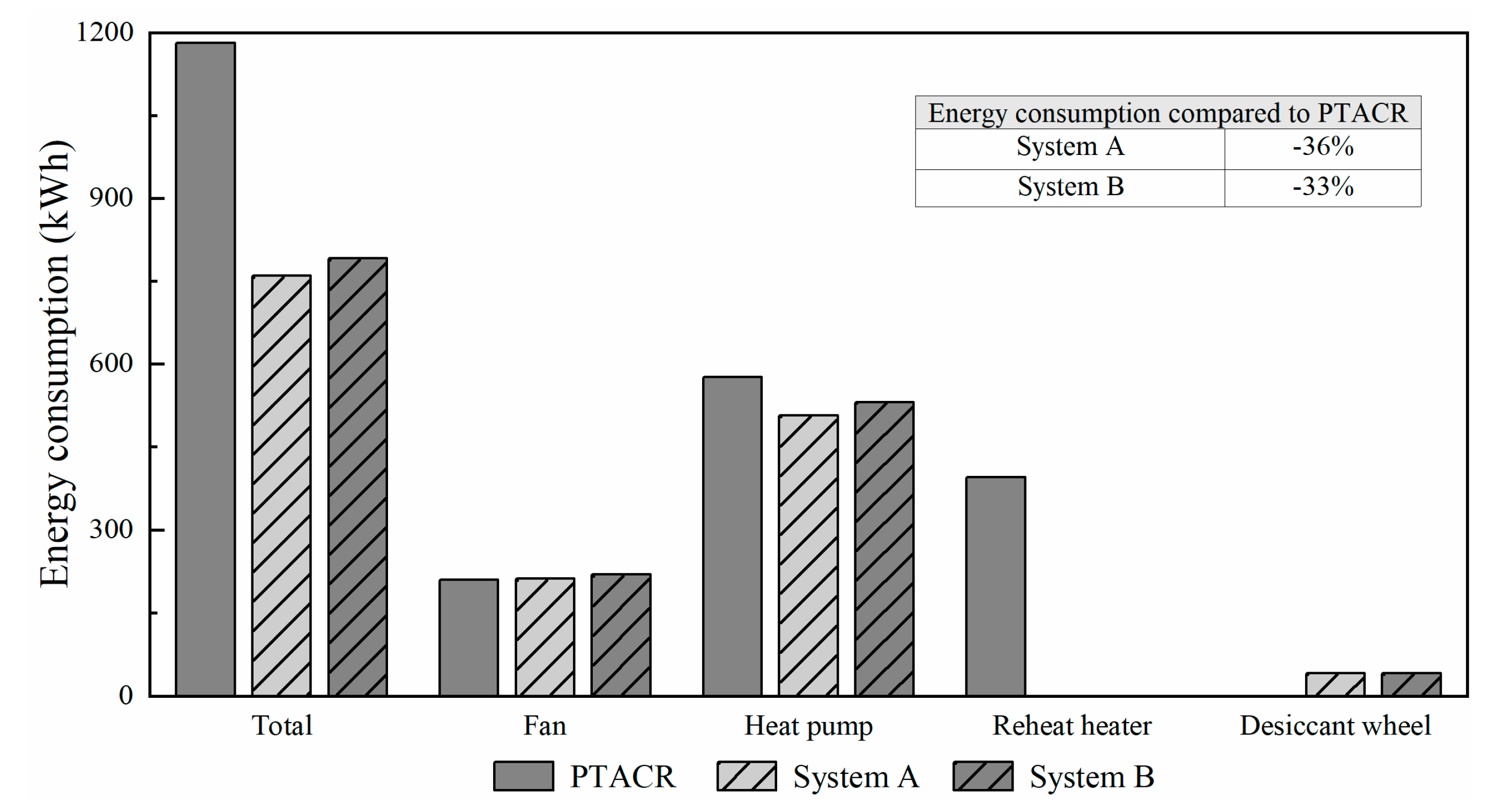
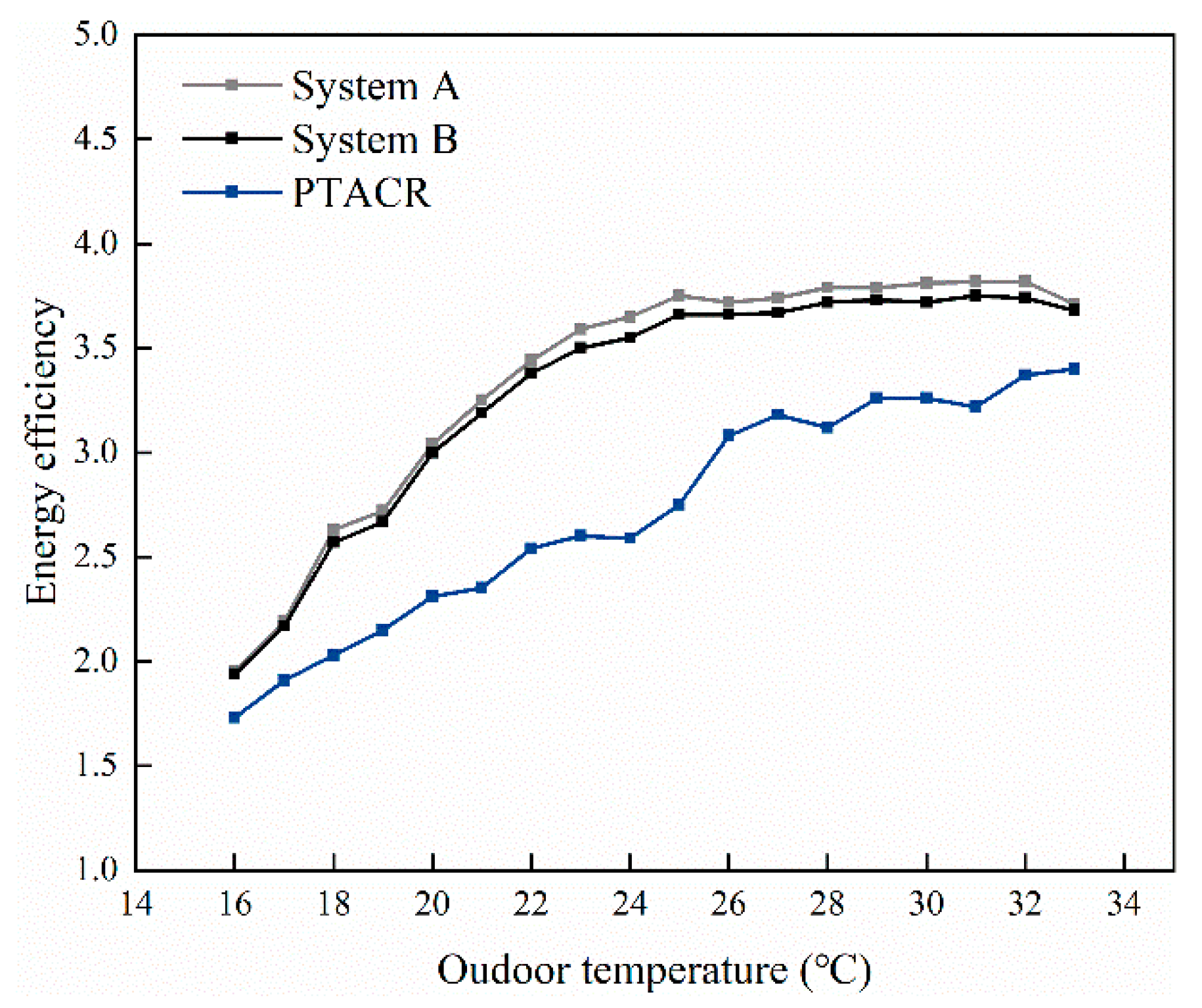
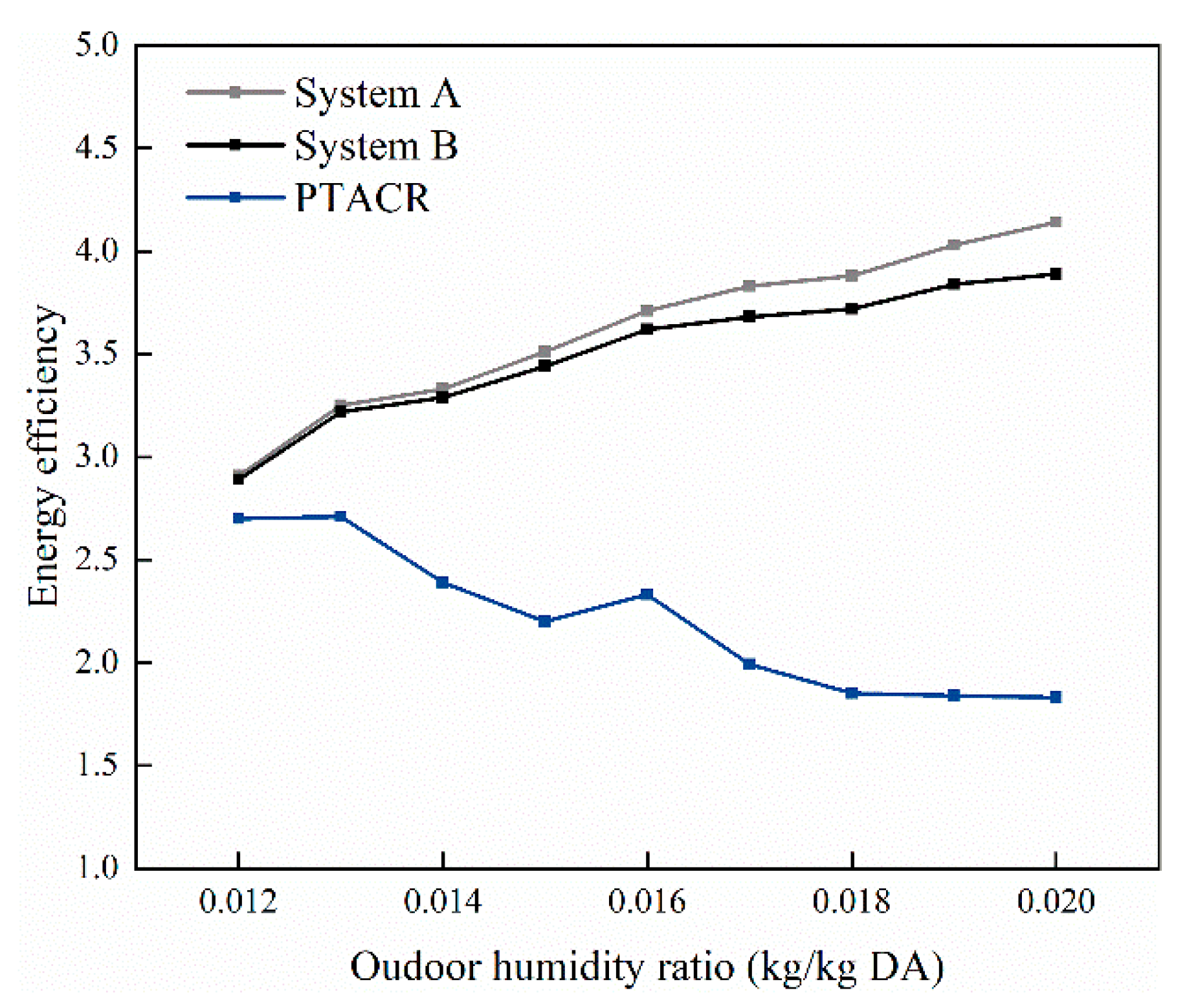

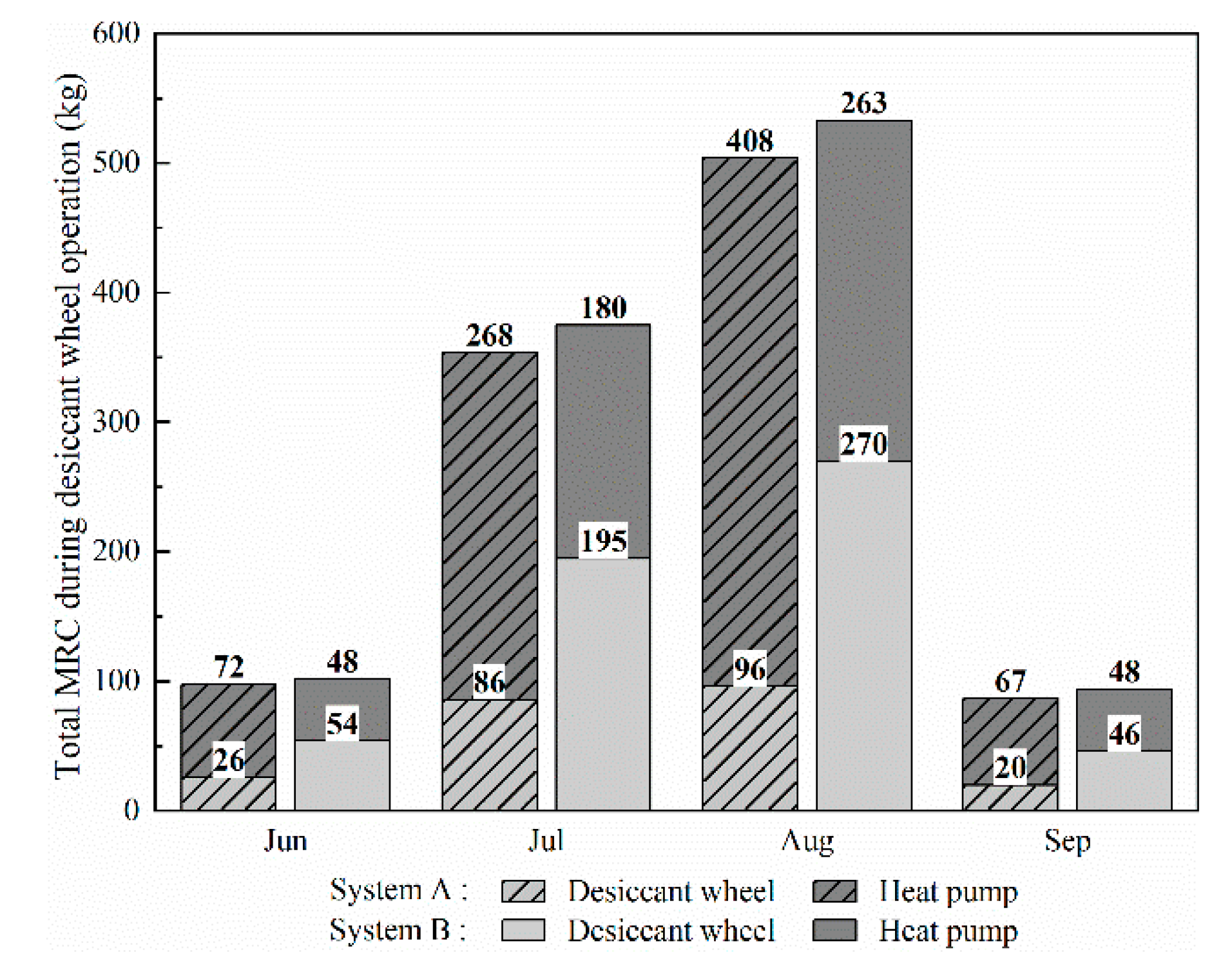

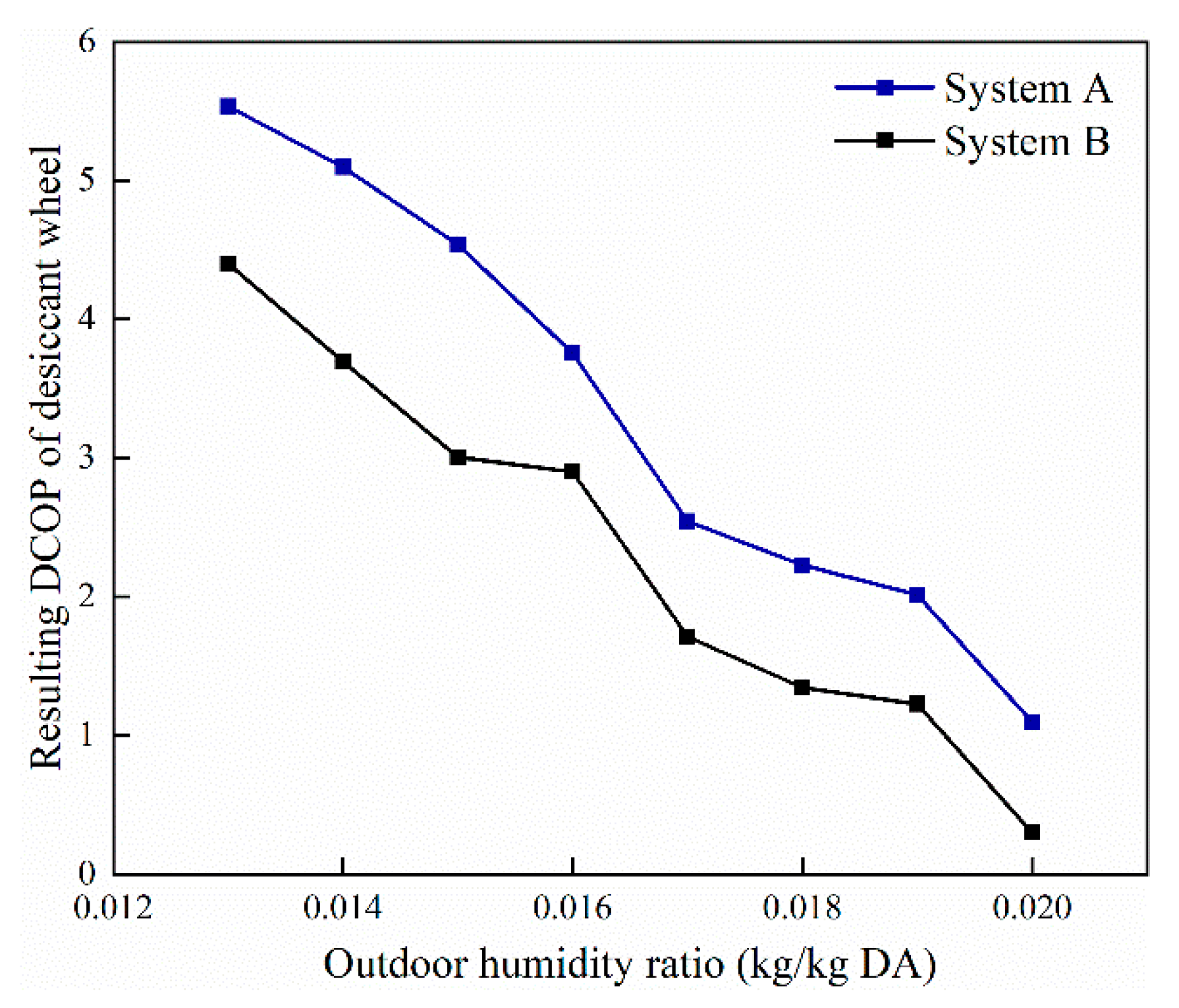




| Items | Input Data | |
|---|---|---|
| Design parameters | Design indoor temperature | 26 °C |
| Indoor relative humidity | 50% | |
| Outdoor environment | Meteorological data of Seoul | |
| System volumetric flow rate | 360 m3/h | |
| Outdoor air volumetric flow rate | 108 m3/h | |
| Internal Loads | Number of occupants | 4 people |
| People | 120 W/person | |
| Light | 6.19 W/m2 | |
| Equipment | Sensible heat: 160 W | |
| Cooking | 15 W (Sensible heat 11.25 W, Latent heat 3.75 W) |
| 1 | 2 | 3 | 4 | 5 | 6 | 7 | 8 | |
|---|---|---|---|---|---|---|---|---|
| 10.73864 | 113.2739 | 0.657 | 11,192.462 | 176.874294 | 0.002073 | −20,705.7 | 0 | |
| −0.00376 | 0.98203 | 8 × 10−5 | −6.070838 | −0.070309 | 4.62 × 10−5 | 8.853729 | 0 |
| 1 | 0.942587793 | 0.8 | 0.342414409 | 1.1552 | 0.85 |
| 2 | 0.009543347 | 0.2 | 0.034885008 | −0.1808 | 0.15 |
| 3 | 0.00068377 | 0 | −0.0006237 | 0.0256 | 0 |
| 4 | −0.011042676 | - | 0.004977216 | - | - |
| 5 | 0.000005249 | - | 0.000437951 | - | - |
| 6 | −0.00000972 | - | −0.000728028 | - | - |
Publisher’s Note: MDPI stays neutral with regard to jurisdictional claims in published maps and institutional affiliations. |
© 2020 by the authors. Licensee MDPI, Basel, Switzerland. This article is an open access article distributed under the terms and conditions of the Creative Commons Attribution (CC BY) license (http://creativecommons.org/licenses/by/4.0/).
Share and Cite
Liu, S.; Jeong, C.-H.; Yeo, M.-S. Effect of Evaporator Position on Heat Pump Assisted Solid Desiccant Cooling Systems. Energies 2020, 13, 5918. https://doi.org/10.3390/en13225918
Liu S, Jeong C-H, Yeo M-S. Effect of Evaporator Position on Heat Pump Assisted Solid Desiccant Cooling Systems. Energies. 2020; 13(22):5918. https://doi.org/10.3390/en13225918
Chicago/Turabian StyleLiu, Shuo, Chang-Ho Jeong, and Myoung-Souk Yeo. 2020. "Effect of Evaporator Position on Heat Pump Assisted Solid Desiccant Cooling Systems" Energies 13, no. 22: 5918. https://doi.org/10.3390/en13225918







